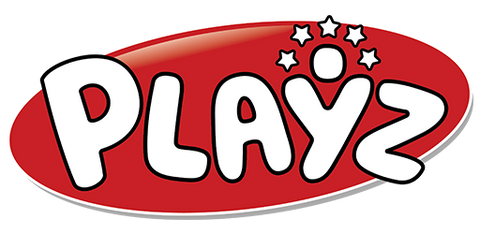
10 Play-Based Learning Activities to Spark Curiosity in 2025
In a world buzzing with distractions, the simple power of play is more crucial than ever. It's not just about having fun; it's the fundamental way children learn about their world, themselves, and each other. Play-based learning activities are the secret sauce to building a lifelong love of learning, transforming abstract concepts into tangible, exciting discoveries. These experiences are the foundation for critical thinking, problem-solving, and emotional intelligence. When a child engages in purposeful play, they are not just passing time, they are actively constructing their understanding of complex ideas.
This guide moves beyond theory to offer a curated list of ten actionable, diverse activities that you can implement today. We will explore how building with blocks lays the foundation for engineering concepts and how a simple nature walk can become a profound science lesson. Each item on our list provides clear instructions, highlights specific learning outcomes, and offers practical tips for parents and educators. Prepare to unlock your child's potential, not through rote memorization, but through the joyful, instinctual language of play. Let's dive into these powerful educational tools.
1. Block Building and Construction Play
Block building is a cornerstone of play-based learning activities, transforming simple construction into a dynamic laboratory for young minds. This foundational activity involves children using various blocks (wooden, foam, magnetic, or even digital) to build structures. Through this hands-on process, they intuitively explore complex concepts like spatial awareness, balance, gravity, and symmetry. It’s a powerful method for integrating STEM learning into playtime, as children naturally experiment with engineering principles and mathematical relationships.
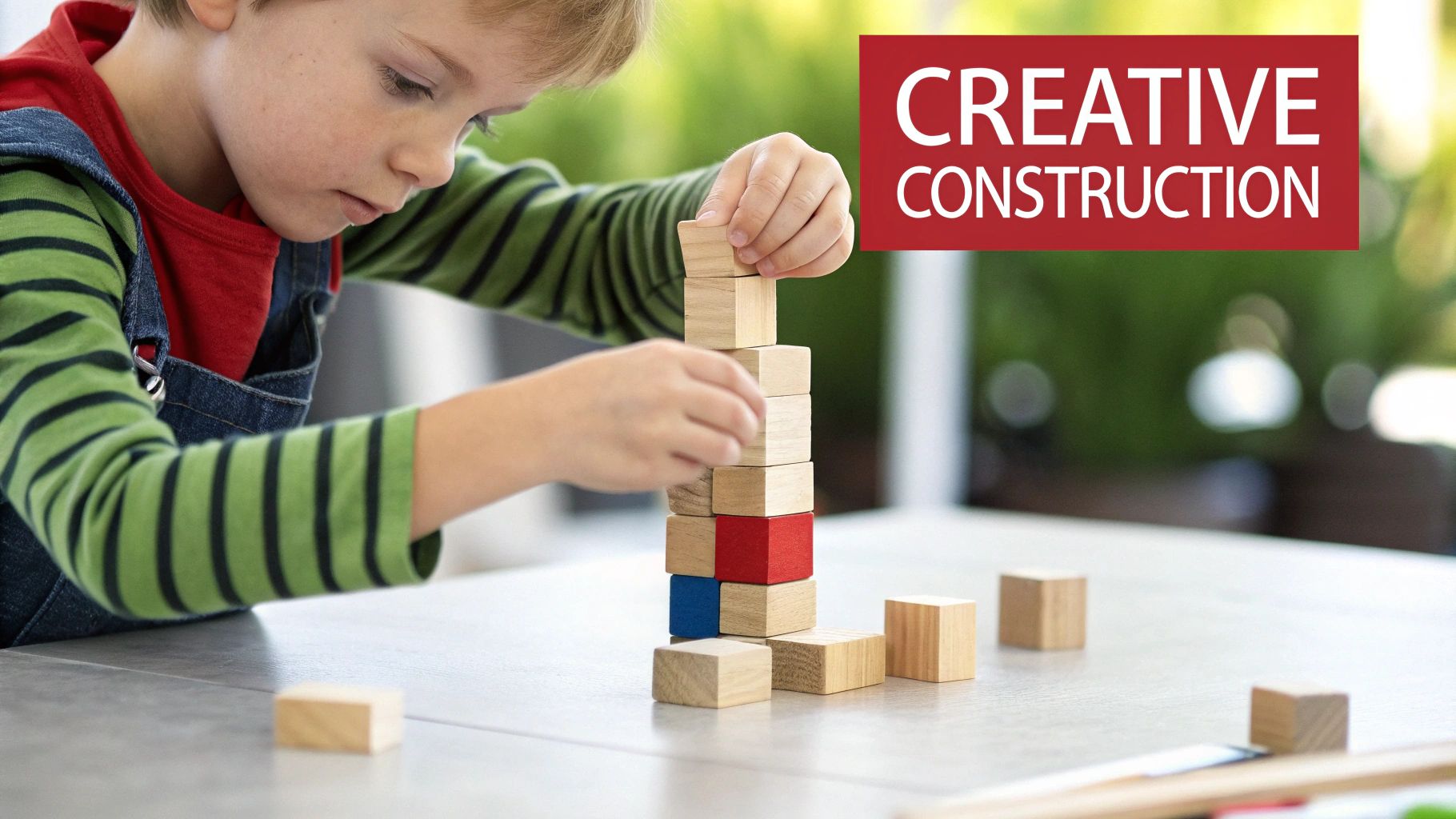
Pioneered by educators like Friedrich Froebel, the inventor of kindergarten, block play is celebrated for its ability to foster creativity, problem-solving, and fine motor skills. As children stack, connect, and arrange blocks, they are also developing persistence and learning to navigate the cause-and-effect nature of the physical world.
How to Implement Block Play
Successfully integrating block play involves creating an inviting environment and gradually increasing complexity.
- Start Simple: For toddlers, begin with large, soft foam blocks that are easy to grip and stack. As their dexterity improves, introduce smaller, more intricate sets like wooden or magnetic blocks.
- Enrich the Environment: Enhance the play area by providing diverse, open-ended materials alongside the blocks. Items like cardboard tubes, fabric scraps, small figurines, and natural elements (like pebbles or sticks) can inspire more imaginative and complex constructions.
- Encourage Critical Thinking: Extend the learning by asking open-ended questions. Instead of saying "That's a nice tower," try asking, "I see you made your tower very tall! What do you think would happen if we added another block on top?" This prompts children to think critically about their creations.
- Set Themed Challenges: For older children, introduce specific challenges to focus their efforts and encourage collaborative problem-solving. Simple prompts like "build a bridge that a toy car can cross" or "design a house for this small animal" can spark incredible innovation and teamwork.
2. Dramatic Play and Role-Playing
Dramatic play and role-playing serve as an immersive theater for child development, where children assume different roles to act out and make sense of their world. This activity allows them to explore social dynamics, practice complex language skills, and develop empathy by stepping into someone else’s shoes. It’s a powerful form of play-based learning activities where children process everything from everyday situations like a trip to the grocery store to grand fantasy adventures.
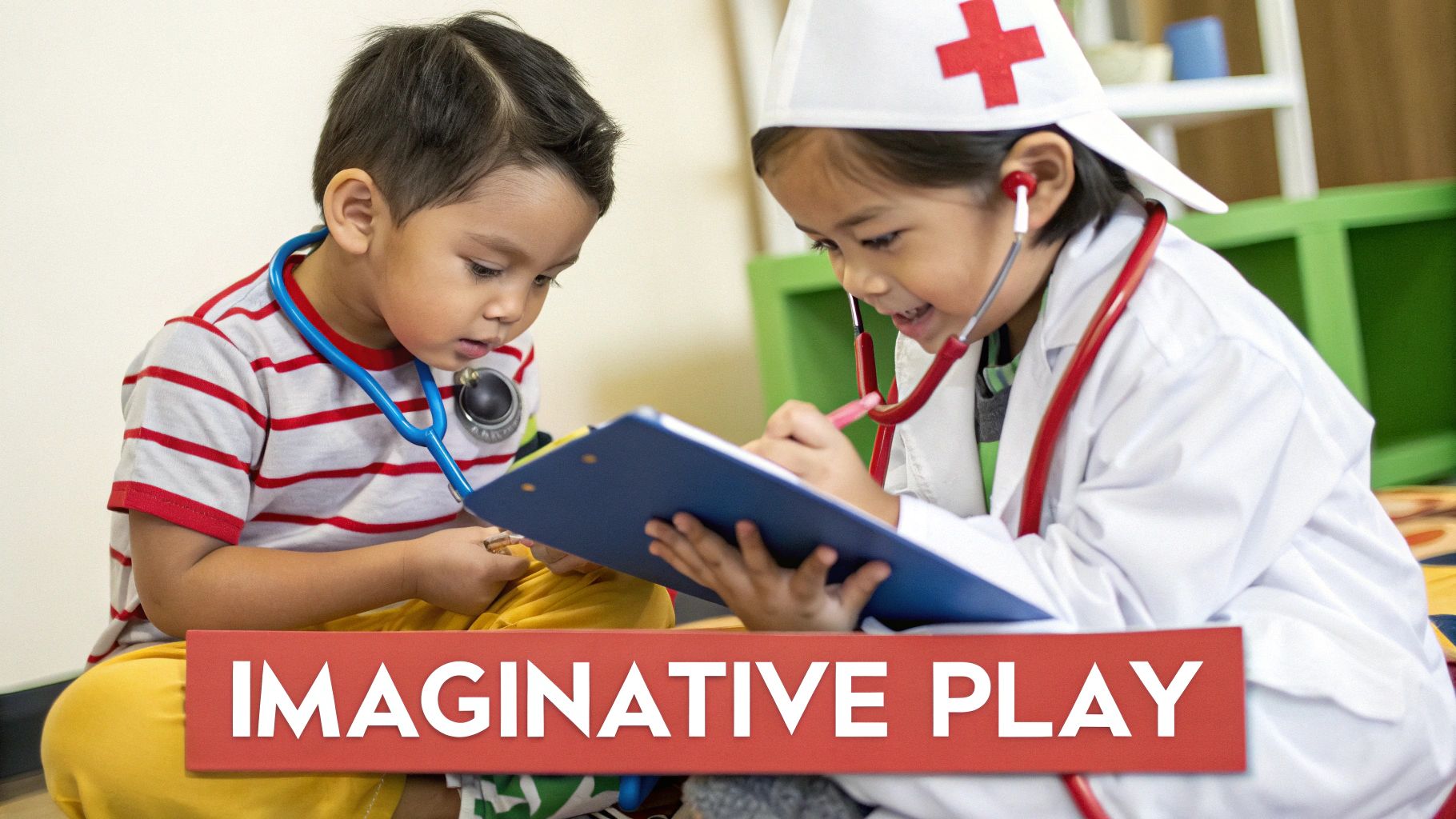
Theories from educators like Lev Vygotsky highlight how role-playing allows children to operate at a higher cognitive level, exploring concepts just beyond their current understanding. This imaginative play is crucial for developing self-regulation, as children must adhere to the rules and social expectations of the roles they adopt, whether they are a doctor, a parent, or a brave knight.
How to Implement Dramatic Play
Creating a rich environment for dramatic play is key to unlocking its full learning potential.
- Start with Simple Props: You don’t need elaborate costumes. Provide open-ended items like hats, scarves, empty boxes, and kitchen utensils. The best toys for imaginative play are often the simplest, sparking creativity rather than dictating it.
- Create Themed Areas: Set up dedicated spaces that suggest a scenario, such as a doctor's office with cotton balls and bandages, a post office with envelopes and stamps, or a simple kitchen area. Rotate themes to keep the play fresh and engaging.
- Model and Extend: Join the play occasionally to model language and gently guide the narrative. If a child is pretending to cook, you might ask, "What are you making for dinner? It smells delicious!" to extend the scenario and encourage verbal expression.
- Connect to Real-Life Skills: Use role-playing to practice real-world situations in a safe environment. Act out ordering food at a restaurant, checking out a book from the library, or navigating a conflict with a friend to build social competence and confidence.
3. Science Discovery Stations
Science discovery stations are dedicated, hands-on exploration centers where children can engage directly with scientific concepts. These stations transform abstract ideas into tangible experiences, allowing kids to conduct simple experiments, observe natural phenomena, and investigate scientific principles through manipulation and observation. This approach to play-based learning activities nurtures a child's innate curiosity and develops foundational scientific thinking skills like predicting, observing, and drawing conclusions.
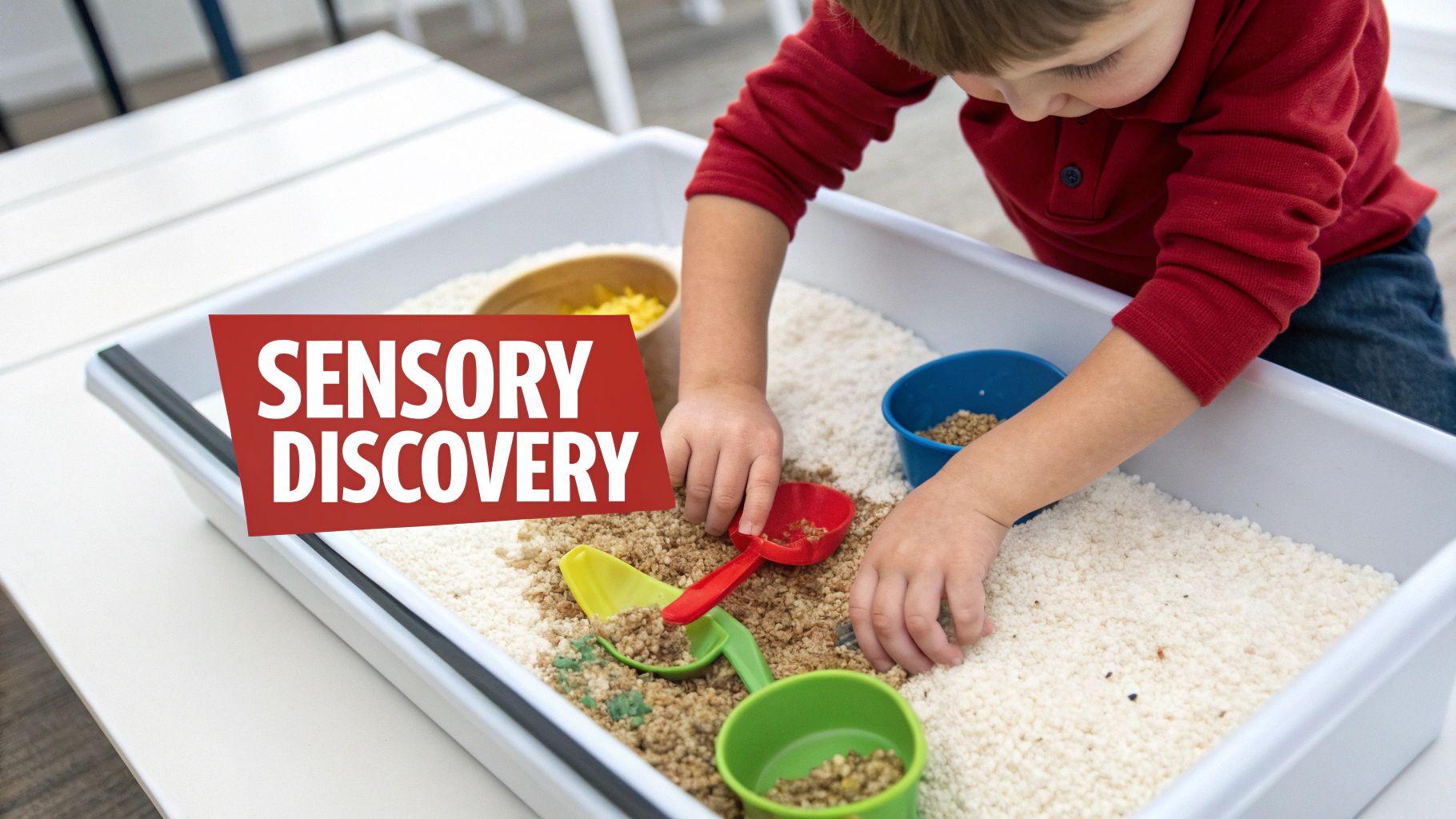
Inspired by pioneers like Frank Oppenheimer of the Exploratorium and the practical life science activities in Montessori education, these stations demystify science. They encourage children to ask questions and seek answers independently, fostering a sense of wonder and empowerment. Whether exploring magnetism, water properties, or plant growth, children learn scientific processes in a meaningful, self-directed way.
How to Implement Science Discovery Stations
Creating an effective science station is about providing the right materials and prompting thoughtful investigation.
- Start with Simple Materials: Begin with safe, household items. A station for exploring water could include bowls, droppers, ice cube trays, and food coloring. A magnetism station might have various magnets and a collection of metal and non-metal objects to test.
- Encourage Predictions: Before they begin, prompt children to guess what might happen. Ask questions like, "What do you think will sink?" or "Which object will the magnet stick to?" This introduces the concept of forming a hypothesis.
- Provide Tools for Observation: Equip the station with simple tools like magnifying glasses, measuring cups, and journals for drawing or charting discoveries. This empowers children to look closer and document their findings like real scientists.
- Connect to Everyday Life: Link the experiments to real-world experiences. After a water-play session, you could discuss how rain forms or why boats float. For a deeper dive into structured science activities, you can learn more about STEM activities for elementary students to expand on these concepts.
4. Sensory Play Activities
Sensory play is a cornerstone of play-based learning activities, engaging children’s senses of touch, sight, sound, smell, and even taste. This method involves tactile experiences with materials like sand, water, play dough, or themed sensory bins filled with rice or pasta. Through this hands-on exploration, children build crucial neural pathways, strengthening their brain’s ability to process and respond to sensory information. It is a powerful way to explore complex concepts like texture, temperature, volume, and cause-and-effect in a calming, child-led manner.
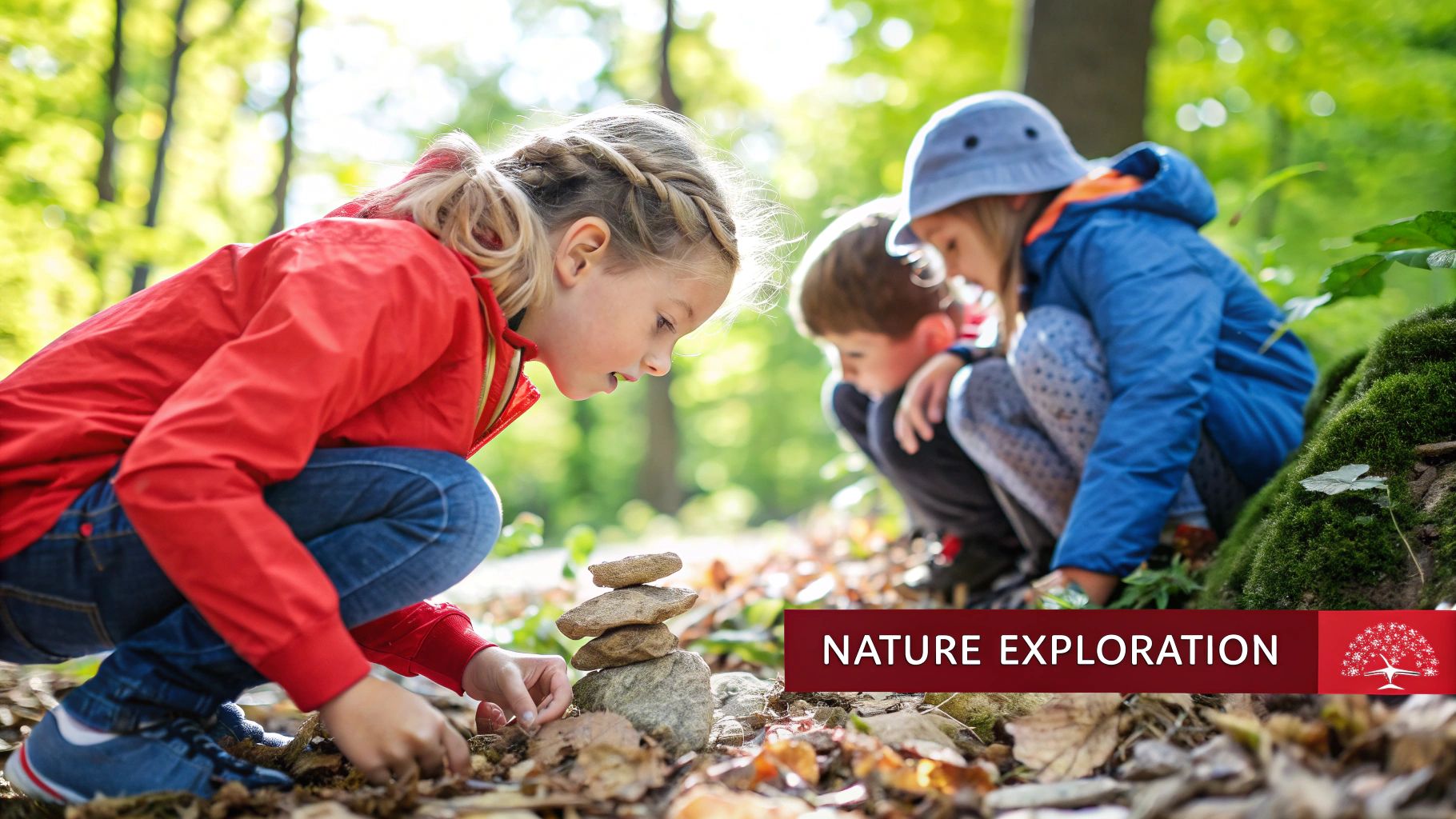
Popularized by pioneers like occupational therapist Jean Ayres and educator Maria Montessori, sensory play is recognized for its ability to support cognitive growth, language development, and fine motor skills. As children scoop, pour, and manipulate materials, they are also developing self-regulation skills, learning to manage sensory input in a controlled, engaging environment.
How to Implement Sensory Play
Integrating sensory play effectively involves creating safe, engaging invitations to explore and providing the right tools to deepen the experience.
- Start with Simple Textures: For children new to sensory play, begin with familiar, non-overwhelming materials like water or dry oats. Gradually introduce more complex textures such as slime, sand, or gelatin as they become more comfortable.
- Create Themed Bins: Connect sensory play to specific learning topics by creating themed bins. A "dinosaur dig" bin could contain sand, small rocks, and toy dinosaurs, while a "garden" bin might have soil, seeds, and small pots to encourage learning about nature.
- Provide Open-Ended Tools: Enhance the experience by including tools that encourage fine motor development. Scoops, funnels, tongs, and brushes allow for different ways to interact with the materials, fostering creativity and scientific thinking. For more ideas, explore these sensory activities for kids on playzusa.com.
- Incorporate Natural Elements: Whenever possible, use materials from the natural world. A bin filled with leaves, acorns, water, and smooth stones provides a rich, multi-sensory experience that connects children to their environment. Always supervise to ensure materials are age-appropriate and safe.
5. Musical Learning Games
Musical learning games are a vibrant form of play-based learning activities that fuse melody, rhythm, and movement to teach a wide array of concepts. This approach uses interactive musical experiences to enhance cognitive, social, and academic development. Children might sing songs about the alphabet, use drums to explore fractions, or dance to reinforce patterns, transforming abstract lessons into memorable, multi-sensory events.
Educators like Zoltán Kodály and Carl Orff championed the integration of music into everyday learning, demonstrating its power to improve memory, language skills, and mathematical understanding. By engaging with music, children naturally develop auditory discrimination, fine and gross motor skills, and emotional expression. It’s an effective way to make learning joyful and accessible to all students.
How to Implement Musical Learning Games
Integrating music into learning is about creating a playful, rhythm-filled environment that supports academic and personal growth.
- Start with Simple Instruments: Introduce accessible instruments like egg shakers, rhythm sticks, drums, and xylophones. These allow children to physically engage with concepts like beat, rhythm, and tempo without needing formal training.
- Create Educational Songs: Turn learning material into catchy tunes. Create simple songs for math facts ("2 plus 2 is 4, let's clap it on the floor!"), science cycles, or vocabulary words. Repetition through song is a powerful memory aid.
- Incorporate Purposeful Movement: Connect music to physical activity to engage kinesthetic learners. For example, have children jump for every syllable in their name or use dance to act out the life cycle of a butterfly while a song plays.
- Use Music for Routines and Transitions: Use specific songs to signal daily activities, such as a cleanup song or a hello song. This helps children anticipate transitions, manage their behavior, and build a sense of community and order.
6. Nature-Based Outdoor Learning
Nature-based outdoor learning transforms the natural world into a dynamic, living classroom, making it one of the most enriching play-based learning activities available. This approach involves children engaging directly with outdoor environments to explore ecosystems, observe wildlife, and learn through sensory experiences. By interacting with nature, children develop a profound connection to their environment while intuitively grasping concepts in biology, physics, and ecology.
Popularized by the Forest School movement and authors like Richard Louv, this educational philosophy is celebrated for its ability to boost physical health, enhance sensory development, and build resilience. As children navigate uneven terrain, identify plant species, or simply listen to the sounds of a forest, they are developing critical thinking, observational skills, and a deep-seated respect for the natural world.
How to Implement Outdoor Learning
Integrating nature-based learning is about creating safe, engaging opportunities for exploration and discovery in any outdoor setting.
- Start Small and Build Confidence: Begin with short, supervised explorations in a backyard or local park. As children become more comfortable, you can gradually extend the time and complexity of your outdoor adventures.
- Equip for Discovery: Provide simple tools to enhance the experience, such as magnifying glasses for examining insects, containers for collecting interesting leaves or stones, and binoculars for bird watching. Always ensure children have appropriate clothing for the weather.
- Encourage Scientific Observation: Give children a nature journal or sketchbook to record what they see, hear, and touch. Prompt them with questions like, "What kind of patterns do you see on this leaf?" or "Why do you think the soil is damp here?"
- Establish Clear Boundaries: Safety is paramount. Clearly define the physical boundaries for exploration and establish simple rules, such as staying within sight of an adult or not touching unknown plants, to ensure a secure learning environment.
7. Art Integration Activities
Art integration is a powerful form of play-based learning activities where creative expression becomes the lens through which children explore academic subjects. Instead of treating art as a separate discipline, this approach weaves drawing, painting, sculpting, and other media directly into learning about science, math, or literature. Children might sculpt the life cycle of a a butterfly, paint a scene from a story, or create a collage representing a historical event, making abstract concepts tangible and memorable.
Pioneered by educators like Rudolf Steiner and the founders of the Reggio Emilia approach, art integration is celebrated for its ability to engage different learning styles, particularly those identified in Howard Gardner's Multiple Intelligences theory. By visually and physically representing their understanding, children develop deeper connections to the material, enhance their fine motor skills, and build creative confidence.
How to Implement Art Integration
Integrating art successfully involves providing rich materials and focusing on the creative process rather than a perfect end product.
- Provide Diverse Materials: Offer a wide array of supplies beyond crayons and paper. Include recycled items like cardboard boxes, natural elements such as leaves and stones, clay, and different types of paint to encourage experimentation.
- Focus on the Process: Emphasize exploration and self-expression. The goal is not to create a masterpiece but to use the artistic process to think, problem-solve, and express ideas. Celebrate the effort and the unique choices each child makes.
- Connect Art to Learning: Tie creative projects directly to topics being studied. If learning about weather, children could create a mixed-media piece showing a stormy day or paint with watercolors to represent a rainbow. For more inspiration, explore these creative learning activities for preschoolers on playzusa.com.
- Display Children’s Work: Create a gallery space in the classroom or home to display the children's creations. This validates their hard work, builds self-esteem, and turns the environment into a celebration of their learning journey.
8. Math Manipulatives and Puzzle Games
Math manipulatives and puzzle games are quintessential play-based learning activities that transform abstract mathematical ideas into tangible, interactive experiences. This approach uses physical objects like counting bears, pattern blocks, and tangrams to help children grasp concepts such as number sense, geometry, and algebraic thinking. By physically moving and arranging objects, children build a concrete foundation for understanding complex mathematical principles.
Pioneered by educators like Maria Montessori and Zoltan Dienes, the use of manipulatives is celebrated for bridging the gap between hands-on exploration and symbolic representation. This method, central to frameworks like Singapore Math, allows children to "see" and "feel" math, fostering deeper comprehension, critical thinking, and a positive attitude towards problem-solving. It effectively turns a potentially intimidating subject into an engaging puzzle to be solved.
How to Implement Math Manipulatives and Puzzles
Integrating manipulatives and puzzles effectively requires creating a supportive and organized environment that encourages exploration and verbalization.
- Start with Free Exploration: Before introducing specific tasks, allow children to freely explore the manipulatives. Let them sort, stack, and create with the materials to become familiar with their properties. This unstructured play builds confidence and curiosity.
- Connect to Representation: As children use the objects, help them link their actions to mathematical language and symbols. If they group three bears and then add two more, you can say, "You have three plus two, which makes five!" and write the equation "3 + 2 = 5."
- Encourage Verbalization: Ask open-ended questions that prompt children to explain their reasoning. Questions like, "How did you figure that out?" or "Can you show me another way to make that shape?" encourage metacognition and solidify their understanding.
- Organize for Accessibility: Create a well-organized "math center" with clearly labeled containers for different manipulatives and puzzles. An accessible system empowers children to independently select materials and tidy up, fostering responsibility and ownership of their learning.
9. Storytelling and Language Games
Storytelling and language games are quintessential play-based learning activities that immerse children in the rich world of narrative and communication. This dynamic approach involves creating, retelling, and dramatically interpreting stories, along with engaging in word games. Through these interactive experiences, children naturally develop vocabulary, comprehension, sequencing skills, and creative expression. It’s a powerful way to build foundational literacy skills in meaningful contexts that feel like pure fun rather than formal instruction.
Popularized by educators like Vivian Paley and central to methodologies like Waldorf education, oral storytelling is celebrated for its ability to foster imagination, empathy, and cognitive organization. When children listen to and create stories, they learn to structure thoughts, understand cause and effect, and connect with diverse perspectives, making it a cornerstone of social-emotional and linguistic development.
How to Implement Storytelling and Language Games
Integrating narrative play is about creating a supportive space for verbal creativity and exploration.
- Use Engaging Props: Enhance storytelling with puppets, felt boards, costumes, or simple props like a "magic" scarf. Visual and tactile aids help make abstract concepts concrete and capture a child's imagination, encouraging active participation.
- Encourage Co-creation: Invite children to create their own stories and characters. Start a story with a simple prompt like, "Once upon a time, in a forest full of glowing mushrooms..." and let each child add a sentence. This collaborative process builds confidence and ownership.
- Retell Familiar Tales: Practice retelling familiar stories like "The Three Little Pigs." This activity reinforces comprehension, memory, and sequencing skills. Use story maps or picture cards to help children visualize the narrative arc from beginning to end.
- Introduce Word Games: Incorporate simple language games into daily routines. Play "I Spy" to build vocabulary and descriptive language skills, or create rhymes and silly songs to develop phonological awareness, a critical pre-reading skill.
10. Cooperative Learning Board Games
Cooperative learning board games are strategic tabletop activities where players work together to achieve a common goal, making them one of the most effective social-emotional play-based learning activities. Unlike competitive games that pit players against each other, these games foster teamwork, communication, and shared decision-making. Through engaging gameplay, children learn valuable life skills like patience and empathy, alongside academic concepts such as math, logic, and strategic planning.
Popularized by innovators like game designer Jim Deacove and the German educational game industry, cooperative games are now widely used in therapeutic settings and progressive educational systems, like those in Finland. They provide a structured environment for children to practice negotiation and problem-solving, turning playtime into a powerful lesson in collaboration and resilience.
How to Implement Cooperative Board Games
Integrating cooperative games successfully means choosing the right game and framing the experience as a team effort.
- Choose Developmentally Appropriate Games: Select games that match the children's age and cognitive abilities. Simple games with clear objectives work best for younger children, while older kids can handle more complex rules and strategic depth.
- Model Collaborative Behavior: Actively participate and model good sportsmanship. Use phrases like, "What do you think we should do next?" or "That's a great idea, let's try it together!" to reinforce the cooperative spirit.
- Establish Clear Expectations: Before starting, clearly explain the rules and the shared goal. Emphasize that everyone is on the same team, working to "beat the game" instead of each other.
- Use Games to Teach Explicitly: Treat the game as a practical workshop for social skills. Pause to discuss challenges, celebrate small victories, and reflect on how the team worked together after the game is over. For more ideas, you can explore the best learning games for kids on playzusa.com.
Comparing Play-Based Learning Activities: A Quick Guide
To help you choose the best activities for your needs, here's a quick comparison of the approaches we've covered. This table highlights their unique strengths and resource needs, making it easier to integrate them into your home or classroom.
| Activity | Core Focus | Resources Needed | Key Benefits | Best For... |
|---|---|---|---|---|
| Block Building | STEM & Spatial Skills | Blocks (wood, foam) | Problem-solving, creativity | Fostering early engineering and math skills. |
| Dramatic Play | Social-Emotional | Props, costumes | Empathy, language, cooperation | Practicing real-world social situations. |
| Science Stations | Inquiry & Observation | Experiment materials | Critical thinking, curiosity | Hands-on, self-directed science exploration. |
| Sensory Play | Sensory & Motor Skills | Bins, sand, water | Fine motor skills, regulation | Calming activities and tactile learning. |
| Musical Games | Cognitive & Rhythm | Simple instruments | Memory, math skills, patterns | Making academic concepts memorable. |
| Outdoor Learning | Environmental & Physical | Access to nature | Resilience, observation skills | Connecting with nature and gross motor skills. |
| Art Integration | Creativity & Expression | Art supplies | Fine motor skills, self-expression | Exploring academic topics visually. |
| Math Manipulatives | Abstract Math Concepts | Counters, blocks | Deeper math understanding | Making abstract math concrete and visible. |
| Storytelling Games | Language & Literacy | Props, imagination | Vocabulary, comprehension | Building foundational reading and social skills. |
| Cooperative Games | Teamwork & Strategy | Board games | Social skills, communication | Teaching collaboration over competition. |
Turning Everyday Moments into Playful Learning
We've explored a diverse landscape of play-based learning activities, from the imaginative worlds of dramatic role-playing to the collaborative strategy of board games. Each activity shares a powerful common thread: authentic learning is an active, engaged, and joyful process of discovery. The fundamental shift for parents and educators is one of perspective—to see the profound educational potential hidden within what looks like simple fun.
Key Takeaways for Making Play a Daily Habit
Integrating these ideas doesn't require a complete overhaul of your routine or a massive budget. The key is to start small and build momentum.
- Observe and Listen: Pay close attention to your child's natural interests. Are they fascinated by bugs? That's your cue for nature-based outdoor learning. Do they love sorting their toys? Leverage that with math manipulatives.
- Reframe Your Environment: Look at everyday objects through a new lens. A pile of pillows can become a fort for engineering practice. A trip to the grocery store can be a storytelling and language game.
- Focus on Process, Not Product: Celebrate the effort and experimentation. An art activity is valuable for the creative process, not just the final painting. The goal of these play-based learning activities is to cultivate curiosity and a love for learning itself.
By embracing this mindset, you empower children to become confident, resourceful, and resilient learners. They develop critical thinking skills not by memorizing answers, but by asking questions and finding solutions. The journey into purposeful play is one of the most rewarding adventures you can embark on with a child. Choose one activity from this list that excites you both, and dedicate time to it this week. You'll be amazed at the learning that unfolds when you simply make space for play.
At Playz, we are committed to creating tools that seamlessly bridge the gap between play and education. Our award-winning science kits are designed to make complex STEM concepts accessible and exciting through hands-on play-based learning activities. Ready to bring more purposeful play into your child's life? Explore our collection at Playz and discover why millions of families trust us to make learning an unforgettable adventure.
